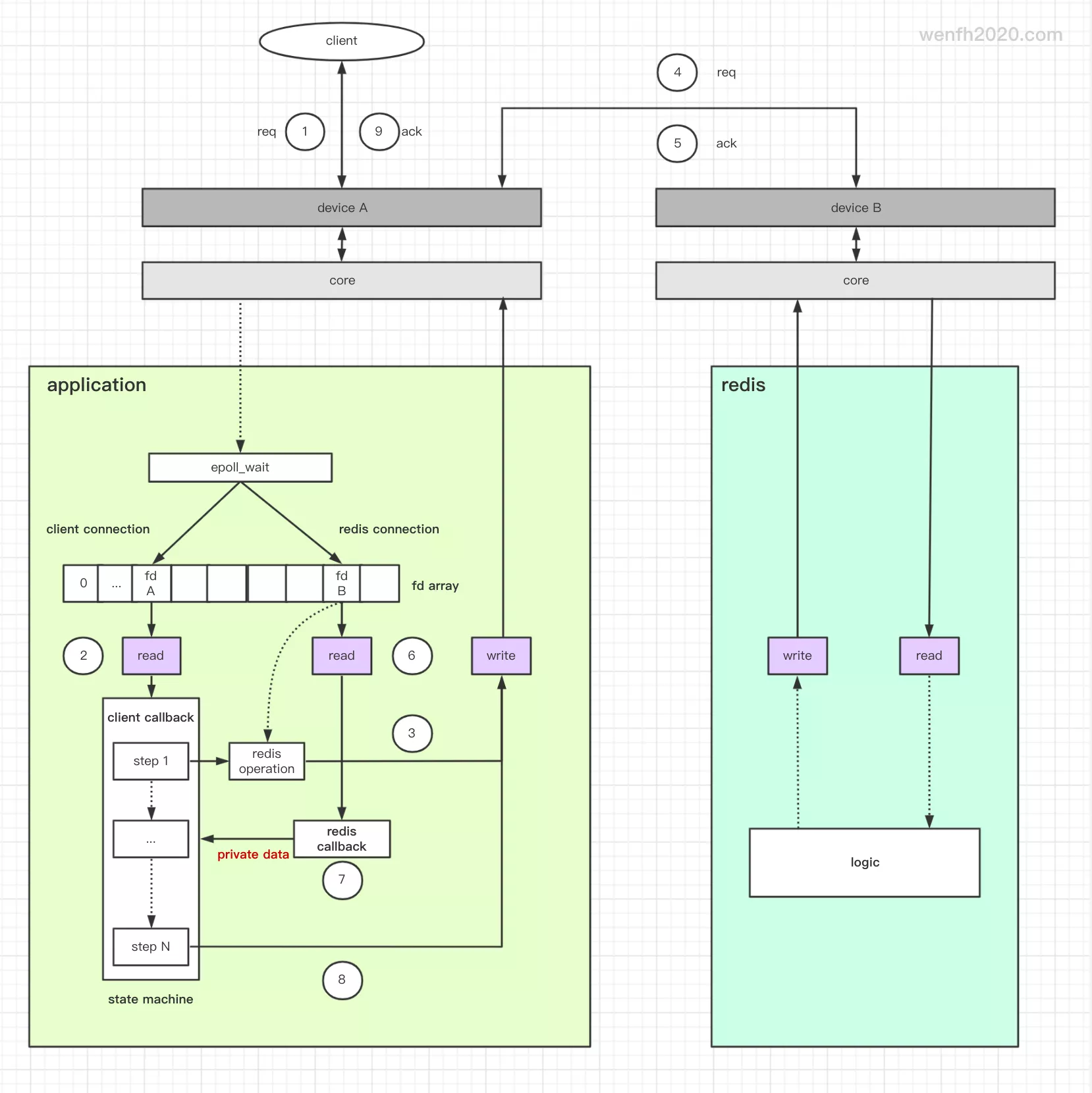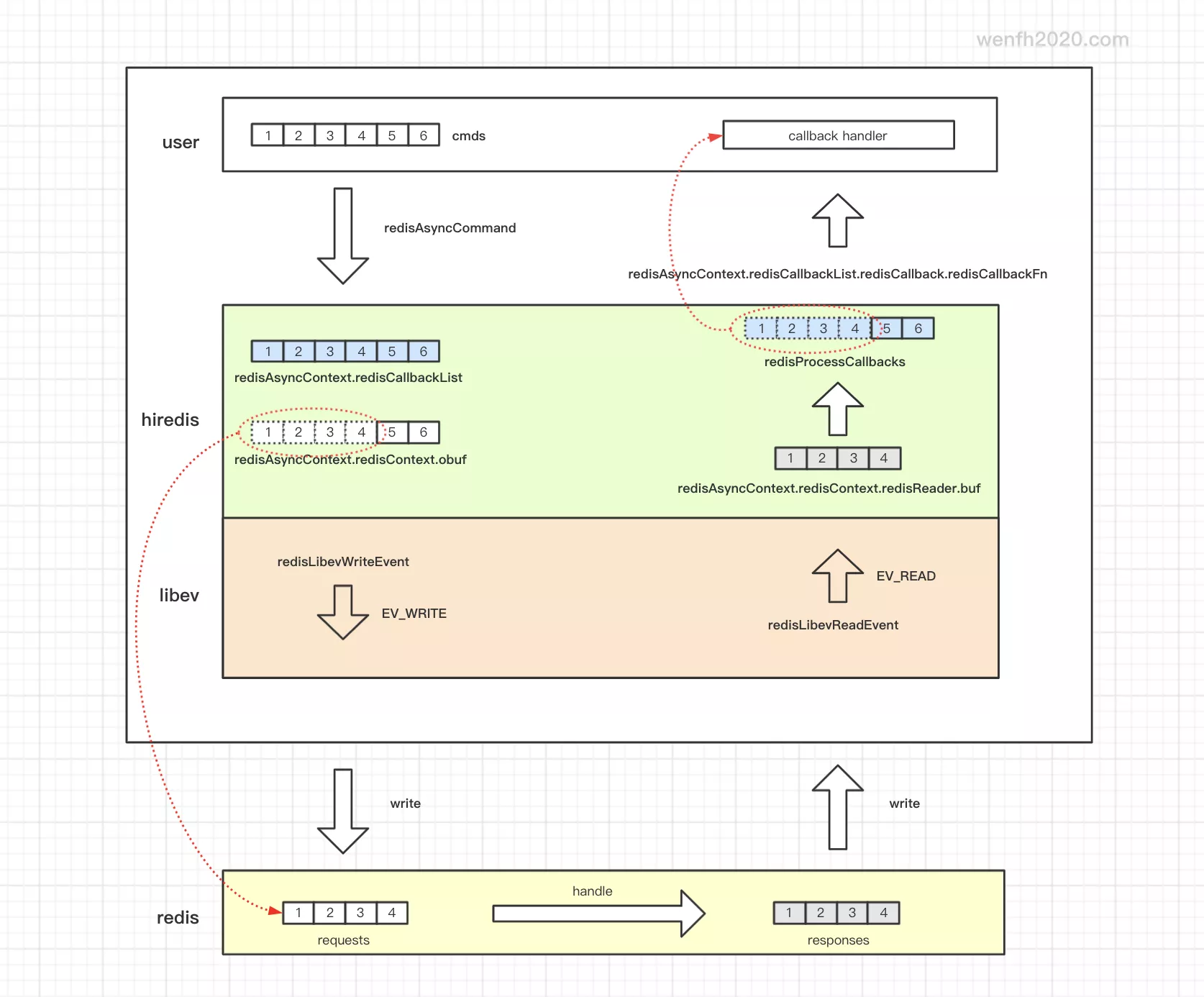hiredis 是 redis 的一个 c - client,异步通信非常高效。
单链接异步压测,轻松并发 10w+,具体请参考《hiredis + libev 异步测试》。
本章主要剖析 hiredis 异步回调机制原理,围绕三个问题,展开描述。
- 异步回调原理。
- 异步回调如何保证 request/response 时序。
- 单链接异步读写 redis,为何能并发 10w+。
1. 异步回调原理
先看看异步通信流程。

设计图来源:《异步服务框架通信流程》
1.1. demo
hiredis demo,除了提供访问 redis 的同步异步接口,还支持大部分主流事件库,它非常实用。
1
2
3
4
5
6
7
8
9
10
11
12
13
14
15
[wenfh2020: hiredis/examples]$ tree
.
├── CMakeLists.txt
├── example-ae.c
├── example-glib.c
├── example-ivykis.c
├── example-libev.c
├── example-libevent-ssl.c
├── example-libevent.c
├── example-libuv.c
├── example-macosx.c
├── example-qt.cpp
├── example-qt.h
├── example-ssl.c
└── example.c
1.2. 使用
hiredis 回调接口使用简单,做得非常精简。例如结合 libev 实现异步回调 demo,只要绑定三个回调接口即可。
1
2
3
4
5
6
7
8
9
10
11
12
13
14
15
16
17
18
/* examples/example-libev.c */
...
void getCallback(redisAsyncContext *c, void *r, void *privdata) {...}
void connectCallback(const redisAsyncContext *c, int status) {...}
void disconnectCallback(const redisAsyncContext *c, int status) {...}
int main (int argc, char **argv) {
...
redisAsyncContext *c = redisAsyncConnect("127.0.0.1", 6379);
...
redisLibevAttach(EV_DEFAULT_ c);
redisAsyncSetConnectCallback(c,connectCallback);
redisAsyncSetDisconnectCallback(c,disconnectCallback);
redisAsyncCommand(c, NULL, NULL, "SET key %b", argv[argc-1], strlen(argv[argc-1]));
redisAsyncCommand(c, getCallback, (char*)"end-1", "GET key");
ev_loop(EV_DEFAULT_ 0);
return 0;
}
1.3. 回调接口
hiredis 异步通信上下文 redisAsyncContext 结构,三个回调接口分别是:
| 接口 | 描述 |
|---|---|
| redisConnectCallback | 连接回调。 |
| redisDisconnectCallback | 断开链接回调。 |
| redisCallbackFn | 正常数据通信回调。 |
1
2
3
4
5
6
7
8
9
10
11
12
13
14
15
16
17
18
19
20
21
22
23
24
25
26
27
28
29
30
31
32
/* async.h
* Reply callback prototype and container */
typedef void (redisCallbackFn)(struct redisAsyncContext*, void*, void*);
typedef void (redisDisconnectCallback)(const struct redisAsyncContext*, int status);
typedef void (redisConnectCallback)(const struct redisAsyncContext*, int status);
typedef struct redisCallback {
struct redisCallback *next; /* simple singly linked list */
redisCallbackFn *fn;
int pending_subs;
void *privdata;
} redisCallback;
/* List of callbacks for either regular replies or pub/sub */
typedef struct redisCallbackList {
redisCallback *head, *tail;
} redisCallbackList;
/* Context for an async connection to Redis */
typedef struct redisAsyncContext {
...
/* Called when either the connection is terminated due to an error or per
* user request. The status is set accordingly (REDIS_OK, REDIS_ERR). */
redisDisconnectCallback *onDisconnect;
/* Called when the first write event was received. */
redisConnectCallback *onConnect;
/* Regular command callbacks */
redisCallbackList replies;
...
};
1.4. 请求回调流程
1.4.1. 请求
每个命令请求回调接口被添加到回调列表:ac->replies。
1
2
3
4
5
6
7
8
9
10
11
12
13
14
15
16
17
18
19
20
21
22
23
24
25
26
27
28
29
30
31
32
33
34
35
36
37
38
39
40
41
42
43
44
45
46
47
48
49
50
51
52
53
/* async.c */
int redisAsyncCommand(redisAsyncContext *ac, redisCallbackFn *fn, void *privdata, const char *format, ...) {
...
status = redisvAsyncCommand(ac, fn, privdata, format, ap);
...
}
int redisvAsyncCommand(redisAsyncContext *ac, redisCallbackFn *fn, void *privdata, const char *format, va_list ap) {
...
// 格式化命令。
len = redisvFormatCommand(&cmd, format, ap);
// 异步发送。
status = __redisAsyncCommand(ac, fn, privdata, cmd, len);
...
}
static int __redisAsyncCommand(redisAsyncContext *ac, redisCallbackFn *fn, void *privdata, const char *cmd, size_t len) {
...
// 回调对象。
redisCallback cb;
...
/* Setup callback */
cb.fn = fn;
cb.privdata = privdata;
cb.pending_subs = 1;
...
// request 关联回调,将每个请求回调添加到上下文的回调链表中。
__redisPushCallback(&ac->replies, &cb);
...
}
/* Helper functions to push/shift callbacks */
static int __redisPushCallback(redisCallbackList *list, redisCallback *source) {
redisCallback *cb;
/* Copy callback from stack to heap */
cb = malloc(sizeof(*cb));
if (cb == NULL)
return REDIS_ERR_OOM;
if (source != NULL) {
memcpy(cb, source, sizeof(*cb));
cb->next = NULL;
}
/* Store callback in list */
if (list->head == NULL)
list->head = cb;
if (list->tail != NULL)
list->tail->next = cb;
list->tail = cb;
return REDIS_OK;
}
1.4.2. 回复
读数据 -> 解包 -> 从回调链表中取头部节点进行回调逻辑处理。
1
2
3
4
5
6
7
8
9
10
11
12
13
14
15
16
17
18
19
20
21
22
23
24
25
26
27
28
29
30
31
32
33
34
35
36
37
38
39
40
41
42
43
44
45
46
47
48
49
50
51
52
53
/* async.c */
void redisProcessCallbacks(redisAsyncContext *ac) {
redisContext *c = &(ac->c);
redisCallback cb = {NULL, NULL, 0, NULL};
void *reply = NULL;
int status;
// 对接收数据进行解包。
while ((status = redisGetReply(c, &reply)) == REDIS_OK) {
...
// 从回调链表结构中取头部节点。
/* Even if the context is subscribed, pending regular callbacks will
* get a reply before pub/sub messages arrive. */
if (__redisShiftCallback(&ac->replies, &cb) != REDIS_OK) {
...
}
if (cb.fn != NULL) {
// 处理回调逻辑。
__redisRunCallback(ac, &cb, reply);
...
}
...
}
...
}
// 从链表中,取头部节点。
static int __redisShiftCallback(redisCallbackList *list, redisCallback *target) {
redisCallback *cb = list->head;
if (cb != NULL) {
list->head = cb->next;
if (cb == list->tail)
list->tail = NULL;
/* Copy callback from heap to stack */
if (target != NULL)
memcpy(target, cb, sizeof(*cb));
free(cb);
return REDIS_OK;
}
return REDIS_ERR;
}
// 调用回调函数。
static void __redisRunCallback(redisAsyncContext *ac, redisCallback *cb, redisReply *reply) {
redisContext *c = &(ac->c);
if (cb->fn != NULL) {
c->flags |= REDIS_IN_CALLBACK;
cb->fn(ac, reply, cb->privdata);
c->flags &= ~REDIS_IN_CALLBACK;
}
}
2. 请求时序
上文已经将请求回调的基本流程描述清楚,请求回调结构是用链表顺序保存的,然而 redis 命令没有提供任何 privdata 参数。那么请求和回调是如何保证时序的?主要基于以下两个条件:
-
tcp 链接。redis 采用 tcp 协议进行通信,tcp 通信具有时序性,链接的每个包是顺序发出去的,顺序被接收,不存在乱序问题。
-
redis 单线程处理命令。redis 单线程处理接收的请求包,不存在多线程/多进程并发处理同一个 client 发送的网络数据,所以顺序发送的命令,将会被顺序接收处理,这样可以保证顺序回复。
redis 6.0 增加的多线程功能,也是每个 client 的命令数据包被独立放在一个线程里处理,所以命令也是顺序处理的。
结合上面两点,可以保证 hiredis 请求异步回调时序。
【注意】 redis 是单进程主线程处理命令逻辑的,但是很多 redis proxy,并不一定是单进程的单线程,所以 proxy 需要解决请求和回调的时序性。
3. 异步高性能原理
单链接异步读写 redis,为何能并发 10w+,主要几个原因:
- redis 高性能特性。
- 非阻塞网络通信。
- 多路复用技术。
3.1. redis 性能
hiredis 异步回调快,是建立在 redis 快的基础上的,详细请参考《redis 为啥这么快》。
3.2. 多路复用技术

首先通信链接 socket 被设置为非阻塞的。
hiredis 接口抽象非常好,封装了第三方库访问接口。例如它结合 libev,Linux 系统下,libev 默认用 epoll 多路复用技术处理读写事件。用户调用 hiredis 的发送数据接口,并不会马上将数据发送出去,而是先保存在发送缓冲区,然后当 libev 触发写事件,才会将发送缓冲区的数据发送出去。
而 redis 的网络事件也是通过多路复用事件驱动处理,当 client 触发写事件,它向 redis 服务发送了一个命令集合,相当于 redis 的 pipeline 管道技术,将多个命令打包发送。redis 接收处理完,将回复命令集合通过 epoll 触发写事件进行发送。相当于每次通信都能处理多个命令,减少了大量 RTT (Round-Trip Time) 往返时间。
1
2
3
4
5
6
7
8
9
/* adapters/libev.h
* 向事件库注册 socket 对应的读写事件。*/
static int redisLibevAttach(EV_P_ redisAsyncContext *ac) {
...
/* Initialize read/write events */
ev_io_init(&e->rev,redisLibevReadEvent,c->fd,EV_READ);
ev_io_init(&e->wev,redisLibevWriteEvent,c->fd,EV_WRITE);
return REDIS_OK;
}


